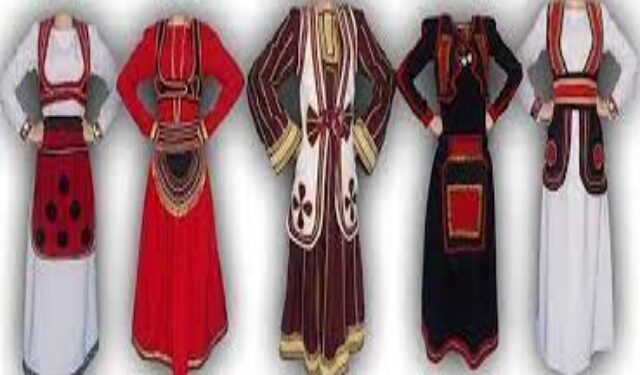The development of clothing has gone in parallel with the social, historical and cultural development of people, having as its main purpose the protection and comfort of the body and then the decoration of individual parts.
Gradually, in the process of development of human society, clothing was created in accordance with the season, with sex, with the occasion when it was used, with age, profession and social class. All these have created that great wealth and variety of clothing. Like all the peoples of the world, the Albanians, although small in number, have this cultural wealth. Over time, ethnic types of Albanian folk clothing were also created. The aesthetic tastes used for decoration, but also the way of styling are what reflect ethnic uniqueness. The entire development of clothing is closely related to the history of the development of this population, and consequently to the history of the Albanian people.
The earliest elements of clothing are considered to be the types of scarves that were thrown over the arms, belts, aprons, hoods, wild animal skins, etc. The types of fibulas, the spindles used for spinning, the weights of the tools, etc., are evidence of the way they were prepared. Over time the pieces of clothing and the materials used to make them were further enriched.
We can speak about Albanian folk clothing after the formation of the Albanian nationality. As is known, the formation of economic and cultural communities among Albanians began in the XII century with the Principality of Arbër. At the time of the formation of the feudal principalities, folk clothing also began to appear. As is known, these principalities were separated, which led to the creation of the diversified folk costumes, the traces of which were preserved until the XXth century. But the differences are also the result of cultural processes that happened after the Turkish invasion. A population category that embraces the Muslim religion fell more under the influence of this culture. Meanwhile, differences were also created by the creation of different social layers as well as by the creation of different professions. However, it should be noted that regardless of the influences of western and eastern cultures or class differences, the early typology of Albanian folk clothing has nothing in common with foreign ones.
Most of the clothing was prepared by the vast peasant masses within the family economy, i.e. woven and sewn with linen, wool, cotton and less silk fabrics. While in the city, in addition to the woven pieces, often a good part of the clothing was sewn and embroidered by the specialized tailors and embroiderers according to the tastes and different requests of the population.
Museum collections for Albanian folk clothing began to be created after the Second World War. Before this period, there were small private collections, collected by the Franciscan priests (about 300 objects). Currently, in the museum funds of the Institute of Popular Culture, over 18,000 pieces of clothing taken from different Albanian provinces inside and outside Albania are stored.
The main types of Albanian folk clothing for men were: xhamadani, a traditional wool garment worn by men. It can be sleeved or sleeveless. The sleeveless xhamadan is only one type of the Albanian vest. A good xhamadan is usually richly embroidered, sometimes in gold: in the past its quality revealed social rank. Albanian men also wore various silver ornaments, such as breastplates, decorative badges on vests, rings, pipes and cigarette boxes, but above all, belt and arm weapons, which were always richly decorated.
For women, the main clothing was the “xhubleta”. It is a traditional folk costume of women, characterized by a bell-shaped bottom, which has a noticeable wavy, especially on the back. Dressing with xhubleta includes all the elements that make up this intricate bell-shaped structure and various accessories, such as shirt, knee-high socks, ornate belts, etc. One of the most fascinating elements of xhubleta is the system of symbols found in the ancient embellishments and designs. Tradition required that this garment be made at home, by young women on the eve of their weddings. A perfect xhubleta must be standing up by itself, without falling. That one taken by the brides as part of their dowry was the wedding xhubleta, used for the wedding day and throughout the first year of marriage and which, afterward, was preserved for the day of death. The other xhubleta –s were for daily wear or events. In the mountain villages, women had from three to nine xhubleta-s each. Xhubleta, which in the Highlands, is also known as the “mountain dress” for women, represents one of the most ancient dresses of a Mediterranean type, which passed millennia to survive to this day. This dress represents a heritage of the material culture from the Illyrians to the Albanians. Thus xhubleta represents the earliest clothing in Albania and the Balkans.
In clothing, colors and ornaments differed according to age. For the young, the provincial costume could be simpler. Unlike other peoples of the Balkans, in Albania, a girl who had reached marriageable age had to be dressed simply and without ornaments, covering her hair well with a scarf and not wearing red clothes. The wedding suit was the richest variant of the province’s clothing, both for brides and grooms. For brides, metal ornaments were indispensable, even used excessively, because here, apparently, not only their aesthetic function was important, but also the magical function attributed to them. For brides, the decoration of the head was of particular importance. A few years after marriage, the dress began to be lightened by ornaments.
/Klara Ruci/



